Aggregate transactions merge multiple transactions into one, allowing trustless swaps, and other advanced logic. Symbol does this by generating a one-time disposable smart contract.

Example of an Aggregate Transaction between two participants. Alice transfers Euros and the ticket vendor transfers the tickets at the same time. The network guarantees that both transactions succeed or none does.
Instead of signing each inner transaction individually, the aggregate transaction gathers all required signatures (called then cosignatures). Only when all necessary signatures have been provided the aggregate transaction can be processed, and all inner transactions are executed simultaneously.
Symbol’s public network supports aggregate transaction containing up to 100 inner transactions involving up to 25 different cosignatories (as defined by the maxTransactionsPerAggregate and maxCosignaturesPerAggregate properties).
Other aggregate transactions are not allowed as inner transactions.
An Aggregate Transaction is complete when it requires signatures from multiple participants and all of them are available when the transaction is announced.
The cosigners can sign the transaction without using the blockchain. Once it has all the required signatures, any one of them can announce it to the network. If the inner transaction setup is valid, and there is no validation error, the transactions will get executed at the same time.
Aggregate complete transactions enable adding more transactions per block by gathering multiple inner transactions.
An Aggregate Transaction is bonded when it requires signatures from multiple participants and NOT all of them are available when the transaction is announced.
Once an aggregate bonded is announced, it enters the partial state and the cosigners whose signatures are still required are notified through their wallets.
When a cosigner signs the transaction and announces its aggregate bonded cosignature, the network checks if all the required signatures are available. If so, the transaction moves to the unconfirmed state meaning that it will be confirmed and included in the next block if everything is correct.
Transactions can remain in the partial state for up to 48 hours: This is the deadline all cosigners have to provide their signatures before the aggregate bonded transaction expires.
Note
Before announcing an Aggregate Bonded Transaction, an account must announce and get confirmed a HashLockTransaction locking 10 XYM. This is refunded when the transaction is confirmed and serves as an anti-SPAM mechanism.

Dan announces an AggregateTransaction that merges two transfer transactions. Alice and Bob will receive the mosaics at the same time.

In this example, Alice is buying tickets with currency.euro mosaic.
When the ticket distributor cosigns the AggregateTransaction, the swap will happen atomically.

Alice sends 10 currency.euro to Bob using an app to make payments.
However, Alice doesn’t own symbol.xym to pay the transaction fee.
By creating an AggregateBondedTransaction, Alice can convert currency.euro to symbol.xym to pay the fee.
Now, Alice and Bob can use Symbol’s public blockchain without ever having to buy or hold symbol.xym units.
Since the app creator can put its own branding on the open source payment app, Alice and Bob may not even know they are using blockchain technology.
